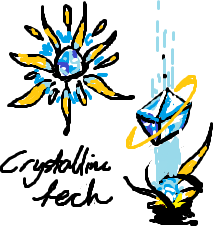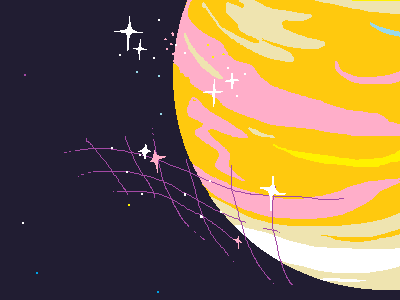Properties
A leftover crystal flickered in a dark corner of my table drawer. Its song was so sad, solemn almost. I moved it to the window, and the tiny crystal pulled itself up towards the stars. The song changed. It was clear and triumphant, and the refracted light shone little rainbows across my window sill.
Crystals are defined by their form and their properties. All crystals naturally absorb radiation, including light, and re-emit the energy as momentum, heat or other forms of radiation. Small crystals have a tendency to hover if unencumbered, and specific strains of crystals are engineered to serve as reactionless propulsion on spacefaring vehicles, taking advantage of the momentum produced. All crystals can slowly regenerate power over time by picking up ambient energy.
Crystalline structures are geometric patterns all the way down to the molecular level. These lattices of perfectly flat facets serve as an ideal base for etching layers of electronic circuits. These circuits enhance the natural abilities of the crystals, or make them capable of storing data or other pattterns.
To a certain extent, all crystals are "trainable," in that they are able to adapt to tasks over time and become more effective at them. While a crystal engineered for propulsion can never become a battery, it can be retrained to work better in bursts or over extended use, or adapted to a new enviroment.
It is widely known that entirely enclosing crystals tends to degrade their effectiveness. Many engineers firmly believe that the crystals themselves operate better when enclosed in beautiful cages of gold, silver, or other precious metals. The latter tendency has been explained by resonance between certain geometric patterns and metals, rather than any kind of aesthetic sense on the part of the crystals.
Colour
Crystals come in all kinds of colours.
Astrallite ranges from pink to purple to blue, while
Aurorite is typically green. Some rarer variants of Aurorite are blue or red.
Song
Crystals produce a gentle sound as they work. It is often described as a gentle hum or a chiming. Those who work with crystals call it singing, and swear that sometimes, they can even understand it.
Localization
The more in tune a crystal is with their location, the better their preformance. Aurorite works best in terrestial spheres, while astrallite is best in space. A crystal can be retrained to work well in new locations, but never quite hit the peaks they might in their natural enviroment.
Hazards
The Crystals used in engines are radioactive and require well-maintained radiation shields. The crystals used for personal tech are either inert or small enough for the radiation to be negligible.
Even fully charged crystals are otherwise fairly safe to handle, but there is a slight risk of explosion if impacted. A shattered crystal will explode violently.













One of the loveliest and most heartfelt explanations of a technology that I've had the pleasure to come across. I love how the crystals yearn for starlight. I imagine them humming happily when absorbing energy and crying to themselves when they're confined. Great work as always!
Learn about the World of Wizard's Peak and check out my award winning article about the Ghost Boy of Kirinal!
Thank you! I like to imagine a mechanic humming away with them. I thought it might be a nice change for the technology to be kind of innately joyful, kind of like technological dogs.